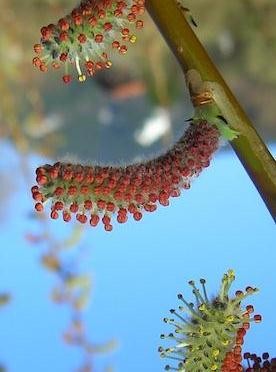Purpleosier willow
(Salix purpurea)

Description
Salix purpurea, the purple willow purpleosier willow or purple osier, is a species of willow native to most of Europe and western Asia north to the British Isles, Poland, and the Baltic States. It is a deciduous shrub growing to 1–3 m (rarely to 5 m) tall, with purple-brown to yellow-brown shoots, turning pale grey on old stems. The leaves are 2–8 cm (rarely to 12 cm) long and 0.3–1 cm (rarely 2 cm) wide; they are dark green above, glaucous green below, and unusually for a willow, are often arranged in opposite pairs rather than alternate. The flowers are small catkins 1.5-4.5 cm long, produced in early spring; they are often purple or red in colour, whence the name of the species (other willows mostly have whitish, yellow or green catkins). It is replaced further east in Asia by the closely related species Salix sinopurpurea (syn. S. purpurea var. longipetiolatea). The weeping cultivar ‘Pendula‘ has gained the Royal Horticultural Society’s Award of Garden Merit. As with several other willows, the shoots, called withies, are often used in basketry. The wood of this and other willow species is used in making cricket bats. The willow genus or willow genus (Salix) is a genus in the willow family, and grows as trees, shrubs, rice or herbaceous dwarf shrubs. The trees in the genus are usually called willow trees, while the more shrub-like species are usually called willow. Otherwise, arrows are usually called the species that have flowering and leaf splitting at the same time, while species that bloom on bare twigs are called willow. The genus has over 400 species. The grayish bark of the wood is smooth or rough and with a wood that often has ridges under the bark. Its winter buds have a bud scales and the leaves are strewn, simple and notched or finely sawn. The willow is a two-story building with flowers gathered in axillary pendants. Fertilizers of willow species have been found in tertiary strata in Europe, Asia and in Arctic regions, and these older species are often close to now living tropical willow species with many stamens. In older Quaternary deposits, modern northern varieties of willow are beginning to emerge. Traces of willow have been found in Italy and in Europe's pre- and postglacial peat layers of several today alpine and arctic species such as dwarf willow, net willow and polar willow.
Taxonomic tree:







